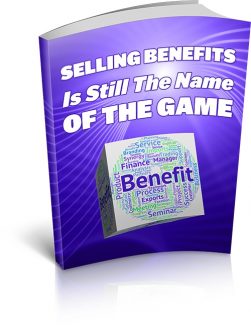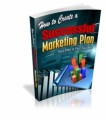 License Type: Master Resell Rights
License Type: Master Resell Rights  File Type: ZIP
File Type: ZIP
 SKU: 62832
SKU: 62832  Shipping: Online Download
Shipping: Online Download
Sample Content Preview
Experts salesmen have always known that it's about selling the benefits, not the product. While it may seem counter intuitive online, the same strategy is still the most important strategy to generate sales for many of the same reasons. Selling benefits appeals to people more than selling features of a product. They directly show what a person will gain by closing the deal. They leave a small opening for imaginative sales pitches, and they clear all objections that are uttered.
Traditional Way To Sell Benefits Offline
There are differences in how those benefits are reiterated online. For one, in a traditional setting, a salesperson is offline, engaged directly with a customer, who can interact with him/her one-on-one. This allows the salesperson to hear the objections that most customers have to buying the product. As any good marketer knows, the minute an objection is raised, the sale is almost finalized. That's because people generally want to be convinced to buy a product; they just have some small issue or objection that they haven't been able to resolve themselves. When a salesperson hears an objection, he/she typically will have a ready response as to why that objection is not the way it is perceived, and frames it differently to produce a statement of benefit for the prospective customer. This allows the customer to rationalize or harmonize his/her feelings so that the final sale is accomplished.
How can you do the same thing online, though, when the customer is anonymous; you don't see him/her and he/she doesn't see you? How do you know what his/her objections will be and what benefits to list when you can't even engage a website visitor to talk to him/her directly? The key is to brainstorm every possible objection that a customer might have and list the benefits of your product on a sales page that includes ALL of them.
The online sales page is the equivalent of your sales introduction to the customer, and it better clearly list the benefits for them to read. If human nature is taken into account, though, you know that no one wants to read a long list of benefits. In fact, they may not even bother to read past the first two sentences of your sales page before deciding that they don't want to read further. What do you do? There are ways to write these sales pages so that the attention is grabbed and gently led down the page in a way that elicits an emotional response that keeps them reading and eager to buy. The next few
The Difference Between Features And BenefitsFeatures And Benefits
Features Are Comprised Of:
- The actual components that make up the product.
- Descriptive paragraphs about the qualities of the product.
- Explanations of a product's performance.
- Pricing for a product.
Obviously, your customer is going to want to know the features of a product, but that isn't what is going to ultimately sell him/her on it. To get him/her to buy the product, you have to list the benefits, not the features.
Benefits Are Comprised Of:
- An explanation of how the product improves the customer's life.
All benefits will answer the simple question that a customer has in mind: What's in it for me? Any statement that answers that question can be considered a benefit to the customer. From this quick explanation, you can see that telling someone who wants to buy eyeglasses that are for nearsightedness and that darken when exposed to sunlight is a feature of the glasses. However, if you tell a customer that he/she will be able to read to his/her grandchildren now and don't have to buy a spare set of sunglasses too, these are both benefits.
In the end, they say about the same thing, but the benefits will highlight some emotional appeal that is part of the reason that the customer went shopping in the first place. He/She didn't go to get a specific prescription for his/her eyes. That he/she leaves up to the optometrist to decide. He/She didn't even go there for the sunglasses; it was just an additional benefit that could appeal to him/her. Very rarely does a person go in with only a specific budget in mind; that budget is flexible when enough benefits make it reasonable to pay a higher price.
Stick to elucidating the benefits of a product or service, and you will sell more, increase your average sales price sold, and have more satisfied customers. Understanding your customer's needs is the basis of all good business, and finding the right
How Demographics Will Help You
If we were to brainstorm benefits for any one product or service, the list could be endless. The problem with this approach is that a benefit is only seen as beneficial if the customer has that need to meet. If you are brainstorming benefits for a new toothpaste, and you come up with the possibility of using it to patch nail holes in the wall, you'll probably elicit peals of laughter, not a sale. Is it a benefit of white toothpaste? There are some people who do use it like a compound, but not that many people would solely go out to buy your toothpaste based on that. The demographics that have a need to fill a hole with toothpaste is pretty small. Obviously, it's not a benefit that you would choose to list online. How do you decide to pick one benefit over another to list on your sales page then? In one word: Demographics.
What Benefits To Highlight
Every website has a specific demographic that it is trying to attract. Your core audience may be comprised of people within a specific income level, educational level, or heritage. You should know as much as you can about the demographics of the people you've attracted so that you can market to them better. If you don't know who is visiting your site, set up some surveys to help you define the demographic better and to reward people for participating with a sales coupon or discount.
The demographics will tell you the amount of money your customers have and what their most pressing concerns might be. It will also give you ideas of what products and services are most important to people who visit your site. If you don't have any idea about income levels, you can always set up three different product lines: cheap, mid-priced, and expensive product lines. You can see which are selling best and to whom and then set up your customer lists this way.








